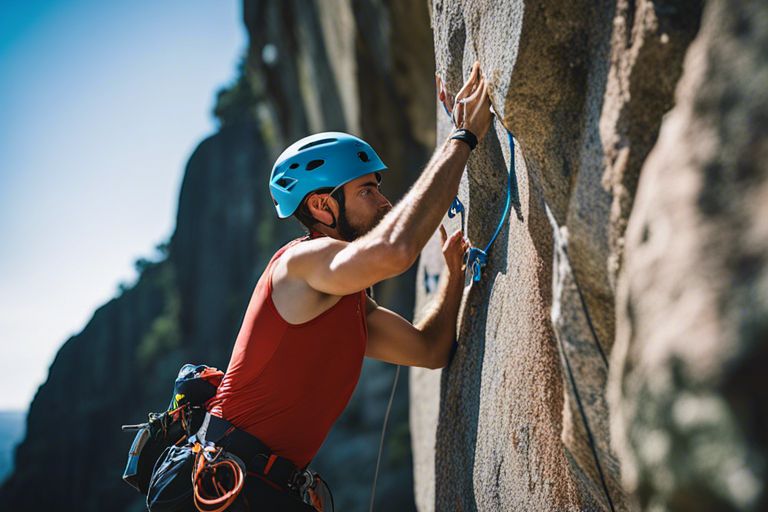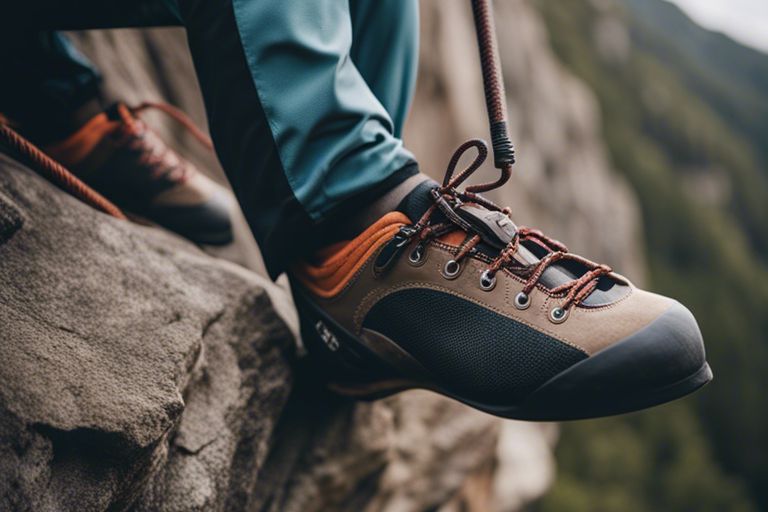You might be wondering how many quickdraws you need for your sport climbing adventures, and it’s a great question that deserves careful consideration. Quickdraws are important for connecting your climbing rope to fixed anchors, providing safety and security as you ascend. The number you require depends on various factors, such as the length of the route, the spacing of the bolts, and your personal climbing style. In this post, we’ll break down the key aspects to help you determine the perfect number of quickdraws for your next climbing excursion.
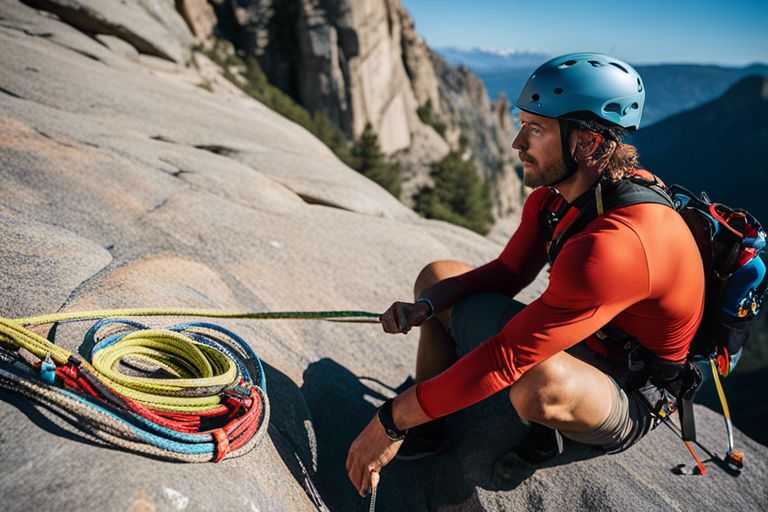
Key Takeaways:
- Route Length: The number of quickdraws you need depends on the length of the climb, as you typically need one quickdraw for each bolt plus one extra for the anchor at the top.
- Type of Climbing: Different routes and climbing styles (e.g., single pitch vs. multi-pitch) may require varying amounts of quickdraws, making it important to adjust your gear accordingly.
- Safety Margin: It’s wise to carry a few extra quickdraws beyond the minimum requirement, as this provides a safety margin for unexpected situations such as gear failure or misjudged routes.
Understanding Quickdraws
Before you head out for your next sport climbing adventure, it’s important to grasp the foundational elements of the gear you’ll use. Among the most critical pieces of equipment for sport climbing are quickdraws, which serve as the connection between your climbing rope and the anchors. A good understanding of quickdraws will help you utilize them more effectively and safely as you navigate your climbing routes.
Definition of Quickdraws
For the uninitiated, a quickdraw is importantly a length of webbing or nylon that has a carabiner at each end. One carabiner attaches to the rock or climbing bolt, and the other is clipped to your climbing rope. The primary purpose of the quickdraw is to facilitate a smooth transition of the rope while providing a critical safety component in case of a fall.
Furthermore, quickdraws come in different lengths and shapes, which can impact their functionality and suitability for various climbing scenarios. Knowing how to choose and use quickdraws effectively will enhance your climbing experience and bolster your safety.
Types of Quickdraws
For climbers, understanding the different types of quickdraws available can greatly inform your gear choices. The basic classifications include straight-gate and bent-gate quickdraws, with each type serving specialized purposes. A straight-gate carabiner is typically used for attaching to the anchor or the bolt, while the bent-gate version is often used for clipping the rope due to its ergonomic design.
- Straight-Gate Quickdraws
- Bent-Gate Quickdraws
- Long Quickdraws
- Short Quickdraws
- Keylock Quickdraws
After gaining a clear understanding of quickdraw types, you can significantly enhance your climbing safety. Below is a summary table underlying the distinction of quickdraws:
| Type | Description |
| Straight-Gate | Used for anchor bolts, securing the quickdraw in place. |
| Bent-Gate | Easy to clip the rope due to its unique shape. |
| Long Quickdraw | Ideal for routes with wide spacing between bolts. |
| Short Quickdraw | Useful for close bolt placements or overhang climbs. |
| Keylock | Features a snag-free design for easier clipping and unclipping. |
Key Features of Quickdraws
Any climber should familiarize themselves with the key features of quickdraws to guarantee a safe climbing experience. One fundamental feature is the strength rating, usually indicated in kilonewtons (kN), which reflects how much load the quickdraw can handle before failure. Additionally, the weight of the quickdraw is another important aspect; lighter quickdraws can make a significant difference during extended climbs.
- Strength Rating (kN)
- Weight
- Gate Type (Straight/Bent)
- Length of the Sling
- Durability Materials
Perceiving these features not only aids in your selection but also ensures you have the right gear for the right climbing situation. Here’s a summary table that underscores the vital features of quickdraws:
| Feature | Importance |
| Strength Rating | Indicates how much weight it can safely hold. |
| Weight | Lighter models are preferable for long climbs. |
| Gate Type | Influences ease of use during clipping. |
| Sling Length | Determines the distance between the bolt and the rope. |
| Durability | Material affects the longevity of your gear. |
Another vital consideration is the design of the carabiners. Features such as the keylock mechanism can prevent snagging when you clip or unclip your rope, adding an extra layer of efficiency and safety to your climbing experience.
- Design for Snag-Free Clipping
- Ergonomic Shapes
- Gate Locks
- Color-Coding for Organization
- Price-to-Performance Ratio
Perceiving these elements will guide you in making informed decisions about your gear. As you get ready for your climbing journey, understanding these facets will prepare you to climb efficiently and safely.
Factors Influencing Quickdraw Requirements
You may be wondering how to determine the ideal number of quickdraws you need for sport climbing. The answer isn’t a straightforward number; it depends on various factors unique to your climbing style, the routes you choose, and the terrain you encounter. Understanding these influences can help you prepare adequately for your climbing endeavors, ensuring you have just the right amount of gear when you tackle different routes.
- Style of Climbing
- Bolt Spacing on Routes
- Climbing Terrain and Complexity
Style of Climbing
Requirements for quickdraws can vary significantly based on your climbing style. If you prefer a more aggressive style, where you push your boundaries on technical leads, you might opt for additional quickdraws to ensure you minimize the risk of long falls. Conversely, if your style leans towards easier grades or if you are on a top-rope, your quickdraw consumption may be less than a climber tackling multi-pitch routes.
Your personal approach to climbing will also dictate how you engage with the route. For instance, climbers who tend to avoid placing gear for protection in favor of relying on fixed bolts may find their quickdraw needs differ from those who appreciate a more traditional, gear-intensive approach, even on sport climbs. Perceiving how these stylistic choices affect your climbing can further influence your quickdraw requirements.
Bolt Spacing on Routes
For the most part, the spacing of bolts on a route plays a significant role in determining how many quickdraws you’ll need. Routes with closely spaced bolts will naturally require fewer quickdraws, while those with wider spacing could necessitate a greater number to ensure that you’re clipped in safely at every critical point. As you choose routes, consider the spacing; this adds an important layer to assessing how many quickdraws to bring.
Moreover, paying attention to whether the route has moderate or overly ambitious bolt spacing can help you assess risks and prepare accordingly. Since some climbers may prefer a more conservative approach when facing larger gaps between bolts, taking a few extra quickdraws to accommodate potential unexpected challenges is often wise. Style can often influence your decision on how many quickdraws to bring when assessing varied bolt placements.
Climbing Terrain and Complexity
Influencing factors such as climbing terrain and complexity are crucial when calculating the number of quickdraws you’ll need. Steep and overhanging routes might require you to clip more frequently due to the potential swings involved, while multi-pitch climbs in a traditional setting may have different placement considerations. As the terrain becomes more technical, you may find yourself needing more quickdraws because of the constant changes in direction and movement.
Quickdraw requirements also increase in complex terrain with varied holds and sequences. When climbing on challenging rock textures or in areas where the routes aren’t straightforward, more clips create added security, allowing you peace of mind as you navigate intricate moves. Recognizing the complexity of the area you’re climbing enables you to pack adequately for safety and efficiency.
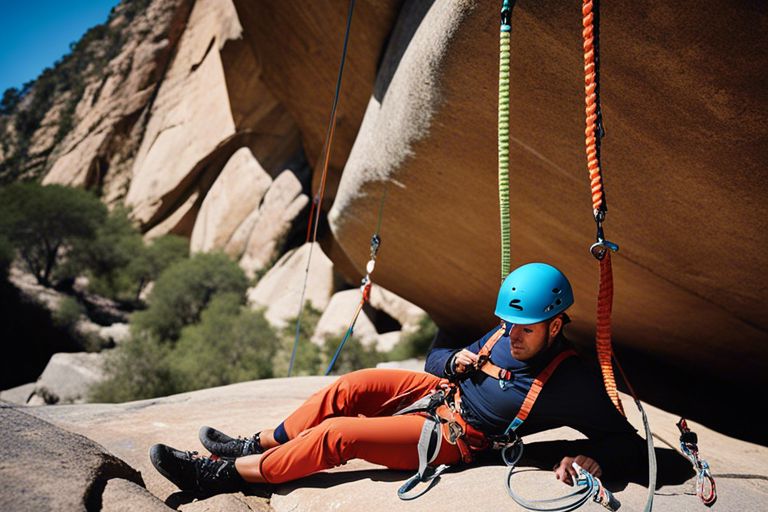
General Guideline for Quickdraw Requirements
Unlike some other climbing disciplines, sport climbing relies heavily on quickdraws to navigate the route safely and efficiently. Understanding how many quickdraws you need can make a significant difference in your climbing experience. The following guidelines will help you determine the appropriate quantity based on your skill level and the type of climbing you’re planning to undertake.
Beginner Climbers
With just starting in sport climbing, you may feel overwhelmed by the equipment needed. A good rule of thumb is to have around 8 to 10 quickdraws in your climbing gear. This will typically be enough for most single-pitch sport routes, allowing you to clip into every bolt and feel secure during your ascent.
As you progress and climb more complex routes or longer pitches, you may find yourself needing additional quickdraws. It’s wise to keep a few extras on hand to accommodate for extended routes or any unexpected challenges that could arise when climbing.
Intermediate Climbers
To enhance your climbing experience and tackle more challenging routes, you should consider increasing your quickdraw collection to about 12 to 16 pieces. This amount will give you the flexibility to climb multi-pitch routes or harder single-pitch routes that may feature additional bolts, thus reducing the likelihood of run-outs.
Requirements for intermediate climbing options often involve considering the specific routes. You may want to carry your quickdraws in a way that allows you to access them easily, especially when you’re climbing challenging terrains. Having several quickdraws on hand also allows you to lend them to climbing partners or use them as extensions on your harness for better reach.
Advanced Climbers
As an advanced climber, your quickdraw needs will be markedly different, given the complexities of the routes you undertake. You may want to have about 16 to 20 quickdraws ready, particularly if you aim at tackling long multi-pitch climbs or the latest sport routes with unusually spaced bolts.
Take into consideration the following factors when building your quickdraw arsenal:
- Route Length: Longer routes will require more quickdraws.
- Bolt Spacing: Tighter spacing might require additional quickdraws to minimize risk.
- Personal Comfort: You should carry enough quickdraws to feel secure and not rushed during your climb.
| Climbing Type | Recommended Quickdraws |
| Single-Pitch Climbing | 12–16 |
| Multi-Pitch Climbing | 16–20 |
A structured approach to organizing your quickdraws can go a long way in improving your climbing efficiency. It’s worth considering the length and type of your rope, as well as how you can maximize your routes—safety and performance will always come first.
- Choose durable quickdraws: They should withstand the wear of intense climbs.
- Incorporate different lengths: This will allow you to handle unique situations better.
- Regularly inspect your gear: Keep your quickdraws in good condition to maintain safety.
| Equipment Quality | Focus on the best gear available. |
| Clipping Techniques | Practice for seamless performance during climbs. |
Quickdraw Setup Strategies
To effectively navigate your sport climbing adventures, having a good understanding of your quickdraw setup strategies is imperative. Each climb presents unique requirements, and your setup can significantly impact your efficiency, safety, and overall climbing experience. Knowing how many quickdraws to bring is just the beginning; you also need to consider how to best use them in various climbing scenarios.
Single Pitch Climbing
One of the most straightforward setups is for single pitch climbing. In this scenario, you’ll typically have a direct and manageable route where you can efficiently place your quickdraws. The number of quickdraws you’ll need usually corresponds to the number of bolts or protection points along the route. A common rule of thumb is to bring a few extra quickdraws in addition to what you expect for the climb—having a couple of backups can save you a lot of hassle should any of your draws get damaged or stuck.
As you start climbing, make sure to place your quickdraws in a way that promotes fluid movement and minimizes rope drag. You’ll want to organize your draws, keeping the ones attached to your harness easily accessible so you can clip them seamlessly as you ascend. This organization emphasizes efficiency, allowing you to focus on your climbing rather than fumbling with your gear.
Multi-Pitch Climbing
Strategies for multi-pitch climbing involve a more complex setup, as you will be navigating various terrains and pitch lengths. In multi-pitch scenarios, consider that the number of quickdraws needed will vary widely depending on the length and difficulty of the route. Often, a general guideline is to have a minimum of 10 quickdraws, but this number could increase based on the number of protection points you encounter along the climb. Additionally, because you’ll likely have different pitches that require different configurations and styles of clipping, organizing your quickdraws beforehand can significantly enhance your efficiency.
Climbing multi-pitch routes can be challenging, but effective quickdraw management is critical. Always remain aware of your surroundings and the dynamics of your climbing partner, as both play a significant role in your setup. Each climber might have a preferred way of clipping and managing their gear, so communicating with your partner about quickdraw positioning and readiness can streamline your ascent. A shared understanding of how to approach each pitch will not only improve your coordination but also ensure that you remain focused on the climbing experience itself.
Route Planning and Quickdraw Management
Route planning is a crucial aspect of any climbing endeavor, especially when it comes to how you manage your quickdraws. Before you initiate on your climb, take the time to research the route and familiarize yourself with the bolting layout. Understanding the spacing between bolts will help you determine the optimal number of quickdraws to carry while preventing unnecessary weight from slowing you down. This advanced planning can also help you anticipate potential cruxes, allowing you to strategize where quickdraws will be needed most.
Another effective technique in route planning is to consider the order in which you’ll utilize your quickdraws. By visualizing the route ahead, you can prioritize the draws you’ll need first and ensure they are easily accessible as you ascend. This foresight will minimize time spent fumbling around for gear, allowing for a smoother climbing experience. Incorporating a systematic approach to managing your quickdraws can greatly enhance your efficiency, allowing you to focus more on enjoying your climb rather than worrying about your gear. Understanding the specifics of each route will not only refine your quickdraw setup but also elevate your sport climbing sessions to a new level of performance.
Recommendations for Quickdraw Quantities
Keep in mind that your climbing experience, the types of routes you plan to tackle, and your local climbing area will greatly influence how many quickdraws you need. In general, it’s advisable to have a good assortment of quickdraws, typically ranging from 12 to 20, to ensure you’re prepared for most climbing scenarios. However, different factors can affect this number, so let’s investigate into some specifics to help you make the best decision for your needs.
Popular Climbing Areas
The number of quickdraws you need can vary significantly depending on the popularity of the climbing areas you visit. For example, if you frequent spots known for longer sport climbs, such as those found in areas like Red River Gorge or California’s Joshua Tree, you might want to lean towards the higher end of the quickdraw spectrum. These areas often feature longer routes with more bolts, meaning you’ll require a greater number of quickdraws to safely navigate them.
On the other hand, if you’re climbing in regions with shorter climbs, like those in many local crags, 10 to 12 quickdraws may suffice. You should consider the specific climbing routes available in your area and the typical route length so you can prepare accordingly.
Route Length Considerations
Route length plays a crucial role in determining how many quickdraws you should bring along. Generally, you want to have at least one quickdraw for every bolt on the route you plan to climb, plus one or two extra for potential backup placements or unexpected situations. Knowing the average route length in your climbing area can help you gauge how many quickdraws you’ll need.
A good practice is to familiarize yourself with the route beforehand. If you’re climbing a route with 10 bolts, plan on bringing at least 12 quickdraws. This way, you’ll have some flexibility if a bolt is missing or if you want to backtrack or bail while climbing. Don’t forget the potential necessity for additional quickdraws if you’re out sport climbing with a partner; you’ll want to ensure you’re both adequately equipped!
Personal Preference and Comfort
Length plays a significant role in how many quickdraws you feel comfortable carrying. Personal preferences differ widely among climbers; some prefer to err on the side of caution and bring extra quickdraws just in case, while others might feel confident with the bare minimum. Assessing your comfort level with the climbing styles you’re engaging in will help you determine the right quantity for your adventures.
It’s vital to consider what makes you feel secure while climbing. If you tend to feel anxious on vertical routes or struggle with headier climbs, having a few extra quickdraws can provide peace of mind and increase your confidence. Ultimately, the best number of quickdraws for you blends practical need with personal comfort, ensuring you’re adequately prepared for every climb.
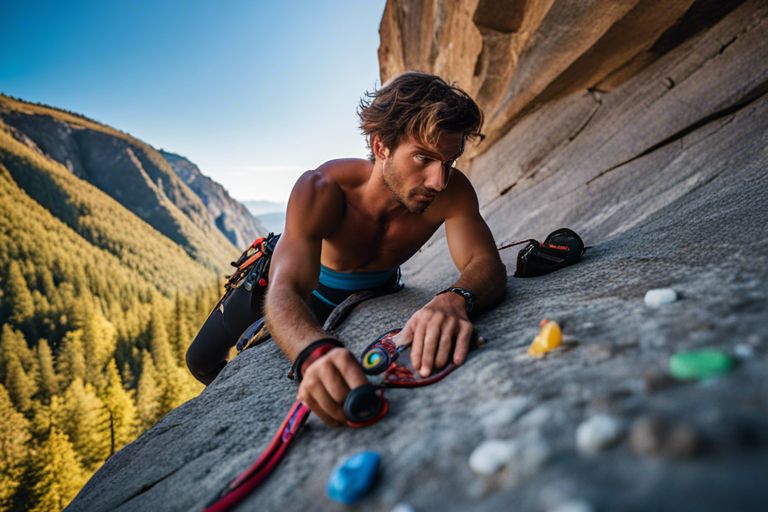
Common Mistakes in Quickdraw Usage
Despite the crucial role that quickdraws play in sport climbing, many climbers make common mistakes that can hinder their performance and safety. Understanding these mistakes can help you make better decisions on the rock and ensure a more enjoyable climbing experience.
Underestimating the Number Needed
With sport climbing routes often featuring multiple draws, it’s easy to underestimate the number of quickdraws you need for a given climb. Many climbers assume that a handful will suffice, only to realize mid-climb that they are short. It’s advisable to evaluate the route beforehand, taking note of the number of bolts present and ensuring you have enough quickdraws, plus a few extra for emergencies or unexpected conditions.
Additionally, the terrain and length of the climb should inform your quickdraw count. Overestimating your efficiency can lead to unnecessary delays, and possibly even dangerous situations if you find yourself without enough quickdraws to remain securely clipped into the route.
Misplacing Quickdraws on Routes
With the adrenaline of climbing, it’s all too easy to clip quickdraws incorrectly or in a hurry, leading to increased risk of falls or inefficiencies. Poor placement can cause a drag, which makes movements more strenuous and can even compromise your safety if a fall occurs. Ensuring quickdraws are clipped correctly, aligned properly, and not crossing lines can make a significant difference in your climbing experience.
For instance, misplacing quickdraws can result in a zigzag effect on the rope path, which not only creates drag but can also lead to increased wear and tear on your gear. Making the effort to clip quickdraws properly will enable a smoother and safer ascent.
Ignoring Maintenance and Quality Checks
Common mistakes often include neglecting the maintenance and quality checks of your quickdraws. Just like any other climbing gear, quickdraws can suffer from wear and tear. Regularly inspecting your quickdraws for any signs of damage, such as frayed webbing, bent gates, or corrosion, is vital to ensure they remain safe for use. Some climbers tend to overlook these checks, assuming that as long as they look fine, they are operational, which is a risky assumption.
Needed inspections should be a routine part of your climbing preparation. Ensure that you familiarize yourself with the lifespan of your quickdraws and replace them when it’s time. Prioritizing maintenance not only boosts your safety but also enhances your climbing performance, giving you the confidence to tackle routes effectively.
Final Words
To wrap up, understanding how many quickdraws you need for sport climbing is crucial for planning your climbing experience effectively. Generally, having a range of 10 to 15 quickdraws will equip you for most sport routes, ensuring you have enough for both shorter climbs and longer climbs where more protection is required. Always consider the specific climb, its length, and the route’s bolt spacing when determining the exact number you’ll need. Additionally, carrying a few extra quickdraws can save you in unexpected situations, such as needing to backtrack or when navigating a less-than-ideal route.
Remember that while the quantity of quickdraws is important, the quality and suitability of the gear you choose are just as crucial. Prioritize durable, lightweight quickdraws that you can trust, as they will directly impact your safety and climbing performance. Review your personal climbing style, the kinds of routes you typically tackle, and adjust your quickdraw inventory accordingly. By carefully assessing your needs and preparing adequately, you set yourself up for successful and enjoyable climbing experiences.
FAQ
Q: How many quickdraws do I need for a typical sport climbing route?
A: The number of quickdraws you’ll need for a sport climbing route generally depends on the length and bolting of the route. For shorter routes, you might need around 6 to 10 quickdraws, while longer routes could require 12 or more. It is also important to consider the spacing of the protection bolts; if they are placed further apart, you will need more quickdraws to ensure safety. Always check the route guide for specifics when planning your climb.
Q: Is it better to have extra quickdraws when sport climbing?
A: Yes, having extra quickdraws is always a good idea when sport climbing. While you might calculate the exact number you’ll need based on the route, it’s smart to bring additional quickdraws in case of unexpected situations, such as having to backtrack or to accommodate for any unforeseen obstacles or route changes. Additionally, having some spare quickdraws can come in handy if you drop one or if you are climbing multiple routes in a day.
Q: Can I use the same quickdraws for different types of climbing?
A: While you can use the same quickdraws for different types of climbing, certain features may be better suited for specific climbing styles. For sport climbing, a lightweight, durable quickdraw with a straight gate on one end and a bent gate on the other is typically ideal. However, if you’re transitioning to trad or alpine climbing, you may require special quickdraws that can handle the dynamic forces involved. It’s imperative to choose quickdraws that align with the requirements of the climbing style you will be practicing.

